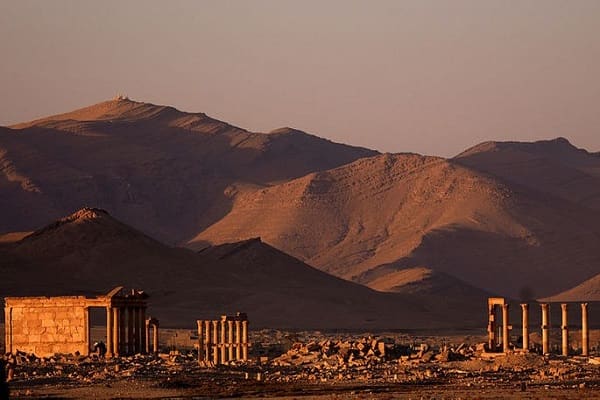The 12 Largest Deserts In The World
Are you curious and want to know about the largest deserts in the world? Naturally, deserts are very dry regions, where the rate of evaporation exceeds the amount of rainfall.
There are deserts where it is cold all year round. In others, summer temperatures can exceed 50ºC! About ⅕ of planet Earth is made up of deserts, the largest of which is a polar desert: Antarctica.

For educational purposes or whichever reason you may need this list for we have provided you with the list of the largest deserts in the world.
The 12 Largest Deserts In The World
1. Antarctica
Size: 14,200,000 km²
Location: South Pole
People don’t generally refer to Antarctica as a desert. But the truth is that much of the frozen continent is indeed a desert. And the biggest in the world!
Antarctica is the driest and coldest continent in the world, and almost its entire surface is covered in ice. It was there that, in 1983, the lowest temperature ever recorded on Earth was measured: -89.2 °C.
2. Arctic
Size: 13,900,000 km²
Location: North Pole
Like Antarctica, much of the region known as the Arctic is considered a polar desert. The Arctic Desert is a vast region that encompasses archipelagos of countries such as Norway and Russia, the Arctic Ocean, as well as part of Greenland and Alaska. Its area is greater than that of the entire European continent.
The Arctic desert is quite cold, with average annual temperatures of -2ºC. Unfortunately, the region has been greatly affected by global warming. One of the consequences of the melting of the polar ice caps is the rise in the level of the oceans.
3. Sahara Desert
Size: 9,200,000 km²
Location: Africa
The Sahara is a subtropical desert located in North Africa, covering a total of 11 countries, including Algeria, Libya, Sudan, Morocco, Tunisia, Egypt and Chad. It is the largest hot desert in the world, with an area equivalent to that of the United States. Almost ⅓ of the vast African continent is covered by the Sahara.
One of the hallmarks of the Sahara Desert is its huge sand dunes, which reach over 180 meters. This is where the famous pyramids of Egypt are located.
4. Arabian Desert
Size: 1,855,000 km²
Location: Middle East
The Arabian Desert is the second largest hot desert in the world, with an area equivalent to that of Mexico. It covers almost the entirety of the Arabian Peninsula, covering countries such as Saudi Arabia, Iraq, Qatar, Jordan and Kuwait.
The largest stretch of the Arabian Desert is the Rub’al khali, with 650 thousand km². Located in the southern part of the peninsula, the Rub’al khali is famous for being the largest continuous sand area in the world, with dunes that can exceed 200 meters in height!
5. Gobi Desert
Size: 1,295,000 km²
Location: Asia
The Gobi Desert is the largest desert in Asia. With an area equivalent to that of Peru, it extends over a vast region in the center of the continent, between northern China and southern Mongolia, occupying about ⅓ of this country’s territory. By way of comparison, the Gobi Desert is three times the size of Uruguay.
One of the characteristics of the Gobi Desert is its extreme temperatures. It can be very hot there in the summer and very cold in the winter. Average temperatures hover around 33ºC in July and -20ºC in the coldest months.
6. Kalahari Desert
Size: 930,000 km²
Location: Africa
The Kalahari Desert is the second-largest in Africa (the first being the Sahara). It is located in the south of the continent, spanning three countries: Botswana, Namibia and South Africa. The Kalahari Desert is almost twice the size of the state of Bahia.
There is no consensus on classifying the Kalahari as a desert. This controversy is due to the fact that the region merges arid and semi-arid regions, including savannas and grasslands.
7. Patagonian Desert
Size: 673,000 km²
Location: South America
The Patagonian Desert is the largest in South America, covering a good part of Argentine territory. The main responsible for the arid and semi-desert climate of Patagonia is the Andes, which promotes the blocking of moisture originating in the Pacific.
With the exception of the so-called “Andean sector”, which is more humid, about 90% of Patagonia is quite dry (arid and semi-arid climate). Another characteristic of Patagonia is the cold – temperatures there rarely exceed 12ºC.
8. Chihuahua Desert
Size: 501,896 km²
Location: North America
The largest desert in North America is shared by Mexico and the United States. Although the region is extremely dry, it contains lakes and rivers, including the Rio Grande (or Rio Bravo, for Mexicans), which establishes a natural border between the two countries.
One of the most interesting features of the Chihuahua Desert is its rich biological diversity, housing a large number of species of cacti, birds, reptiles and amphibians.
9. Great Basin Desert
Size: 492,000 km²
Location: North America
The Great Basin is bordered by the Rocky Mountains (to the east) and the Sierra Nevada (to the west). The Great Basin Desert is nearly the size of Spain.
The dry climate of the Great Basin is due to the wall of the Sierra Nevada, the imposing mountain range located in the east of the state of California, which blocks the humidity originating from the Pacific Ocean with its incredible 4,421 m of altitude.
10. Syrian Desert
Size: 470,000 km²
Location: Middle East
The Syrian Desert is a vast arid region located in southwest Asia, straddling the north of the Arabian Peninsula and stretching across Iraq, Jordan and Syria. About ⅔ of Syrian territory is taken over by the desert. The Syrian Desert is almost twice the size of the UK.
The climate in the Syrian Desert is quite dry and hot, although in winter temperatures can be below 10ºC. Despite being located in the desert, Syria’s capital, Damascus, benefits from milder temperatures (it is on a plateau) and a wetter climate.
11. Great Victoria Desert
Size: 422,466 km²
Location: Oceania
The Great Victoria Desert is the least populated region in Australia. This is explained by its extremely dry climate and extreme temperatures.
There are good portions of sand dunes and pebble-covered plains. One of the hallmarks of the greater Australian desert is its great diversity of reptiles, such as lizards and snakes. One of the snake species that inhabit the Great Victoria Desert is the inland taipan, the most venomous snake in the world!
Read Also: Top 20 Safest Airlines in the World (AirlineRatings)
12. Karakum Desert
Size: 350,000 km²
Location: Asia
The Karakum Desert is located in Central Asia, occupying about 70% of Turkmenistan’s territory. In the Turkic language, Karakum means “black sand”.
One of the most curious facts about Karakum is the “Porta do Inferno”, a huge crater 69 m wide by 30 m deep that has been spewing fire since the 1980s. from the bottom of the hole. But no one can say for sure how it started.

![The 10 Richest Women in South Africa 2022 [Forbes Updated] 3 The 10 Richest Women in South Africa [Forbes Updated]](https://allroundgist.com/wp-content/uploads/2022/03/richest-women-in-south-africa-img_11221-min.jpg)





https://t.me/iGaming_live/4872
Your point of view caught my eye and was very interesting. Thanks. I have a question for you.
Your article helped me a lot, is there any more related content? Thanks!
Your article helped me a lot, is there any more related content? Thanks!